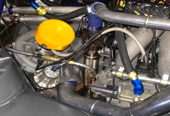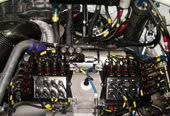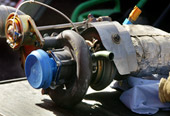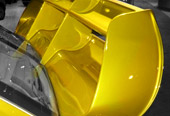Gp.A / WRC
In 1997, the FIA sought to strengthen the somewhat uncertain future of the WRC by introducing a special Group A standard. This was the World Rally car specification, designed to open up the sport to as many manufacturers as possible. Toyota introduced the Corolla WRC in the 1000 Lakes rally 1997 but Mitsubishi still conforming to the group A car until they homologated a Lancer Evolution WRC from the 2001 San Remo Rally.
FIA rules say that WRC World Rally Car cars must be based on a standard road car bodyshell. To get the FIA homologation the manufacturers have to produce only 50 units (Group A a vehicle has to be produced to numbers above 2500 units). All WRC cars have 2.0 litre engine, turbocharger and four wheel drive.
 Subaru 04 WRC |
 Mitsubishi WRC engine |
|
 Citröen Xsara WRC |
 Mitsubishi WRC |
|
 Subaru 04 WRC |
 Subaru 04 WRC |
|
 Subaru WRC-vaihteisto |
 Peugeot 207 S2000 |
|
 Citroen WRC |
 Turbocharger |
|
 Mitsubishi WRC |
 WRC Rear spoiler |
Compared to group A the WRC rules example alloys modified front and rear suspension layout, attachment points and also modified engine position. The engine can be relocated by a maximum of 20 mm as compared to its original position and can be tilted by 20° around the crankshaft axis.
The rules requires engine to have a 34 mm restrictor in the air intake, which holds down power output to around 300 bhp. That is, it’s not true.... real power is around 370 - 380 hp (seen with my own eyes - old Mitsubishi gp.A, dyno 350 hp).
Torque is massive up to around 750 - 850 Nm. This means that a power output in excess of 300 hp is available all the way from 3000 rpm to the red line of ~7500 rpm with a peak of at around 5500 rpm. Sequential gearbox and elecronics allow driver make clutchless gearchanges, a new wrc gearbox cost about 70 - 90 000 €. A used privately owned proper WRC car will be charged +350 000 euros (+550 000$).
Tyres and brakes
From the beginning of the 2008 season, all World Rally Car entrants will use tyres from a single supplier. It's forbidden for competition cars running on less than four wheels to be driven on liaison sections. A set of competition tyres will last around 100 km. The brakes impress! Watercooled calipers and monstrous discs +360 mm are not uncommon on tarmac events. These can be wrapped by eight-pot calipers up front and four-pot variants at the rear. To help slide the rear on asphalt, the handbrake system is hydraulic and so very efficient.
Turbochargers
Even so, a water-cooled WRC turbo CHRA will still be produced from cast iron, whereas magnesium alloy remains the material of choice for WRC turbocharger compressor housings. Example Garrett TR30R (used in many WRC cars) scales at a about 4 kg, whereas a MHI Lancer Evo 9 GSR turbo represents a 10 kg mass! WRC Turbochargers units cost between 6000 - 12 000 € (euros).
Turbo boost is 3 - 5 bar and anti-lag systems mean the turbocharger delivers maximum boost from tick-over. ALS - Anti-Lag System is an engine management technique that allows to minimize the turbo lag time. Example Impreza WRC2008 produces up to a 60 psi (4 bar) of boost. A turbo restrictor is essentially a tube fitted directly on the turbocharger's air intake. The turbo restrictor's effect is mostly noticed in above 5000 rpm.
Aerodynamics
Rules allow spoilers and other aerodynamic aids that you will not see on a road car. Engine cooling is another aerodynamic consideration. Ford 2003 features dramatically restyled aerodynamics and made aerodynamics 'revolution' for WRC cars.
Safety
The cars are fitted with a full roll cage. The overall length of these pipes reaches 50 meters. Cars include also safety fuel shell, fire extinguishers, special seat and seat belt harnesses. The crew must wear approved fireproof underwear, suits, helmets and Hans® device. All of this equipment is scrutinized by event officials before the start of each event. In FIA World Rally Championship all cars are fitted with a GPS safety tracking system which allows Rally Control to see where they are at a glance.
1.6T World Rally Car (WRC)
FIA "The date for introduction of the 1600cc turbo engine for the WRC car has been brought forward to 2011 to bring it in line with the engine used in the cars on sale to the public."
| Group A | WRC | 1600 WRC (2011-) | ||
| Year 1986- | Year 1997- | Year 2011- | ||
| 1600 cc, turbocharger, antilag | ||||
| 33 mm inlet restrictor | ||||
| 4WD | ||||
| |
Turbo boost: 2,5 bar limit | |||
| 300 - 330 hp | ||||
| 500 - 600 Nm | ||||
| Max.compression ratio: 10:1? | ||||
| 4 - 6-speed dogbox | ||||
(Active diffs banned in year 2006) |
Mechanical differentials | |||
| Max. track width: | Max. track width: 1550 mm | |||
| Maximum width: | Max. width: 1770 mm | Maximum width: | ||
| Minimum length: | Minimum length: 4000mm | Minimum length: | ||
| Min.weight: 1200 kg | ||||
(Focus WRC -02 measured ~ 4,4 s) |
0 - 100 km/h 3,6 - 4,5 sec | |||
| Top speed 200 - 220 km/h | ||||
| price: 300 000 - 450 000 € ? | ||||
Cars: Mitsubishi Lancer Evo, Subaru Impreza, Ford Escort, Toyota Celica GT-Four, Lancia Delta Integrale etc. |
Ford Focus WRC, Peugeot 307 WRC Subaru S12 WRC, Skoda Fabia WRC Hyundai Accent WRC, Toyota Corolla WRC, Skoda Octavia WRC etc. |
Ford Fiesta RS WRC, Citröen DS3 WRC, Mini? |
*prices used - new





